SUSTAINING LONE STAR’S STEEL HISTORY
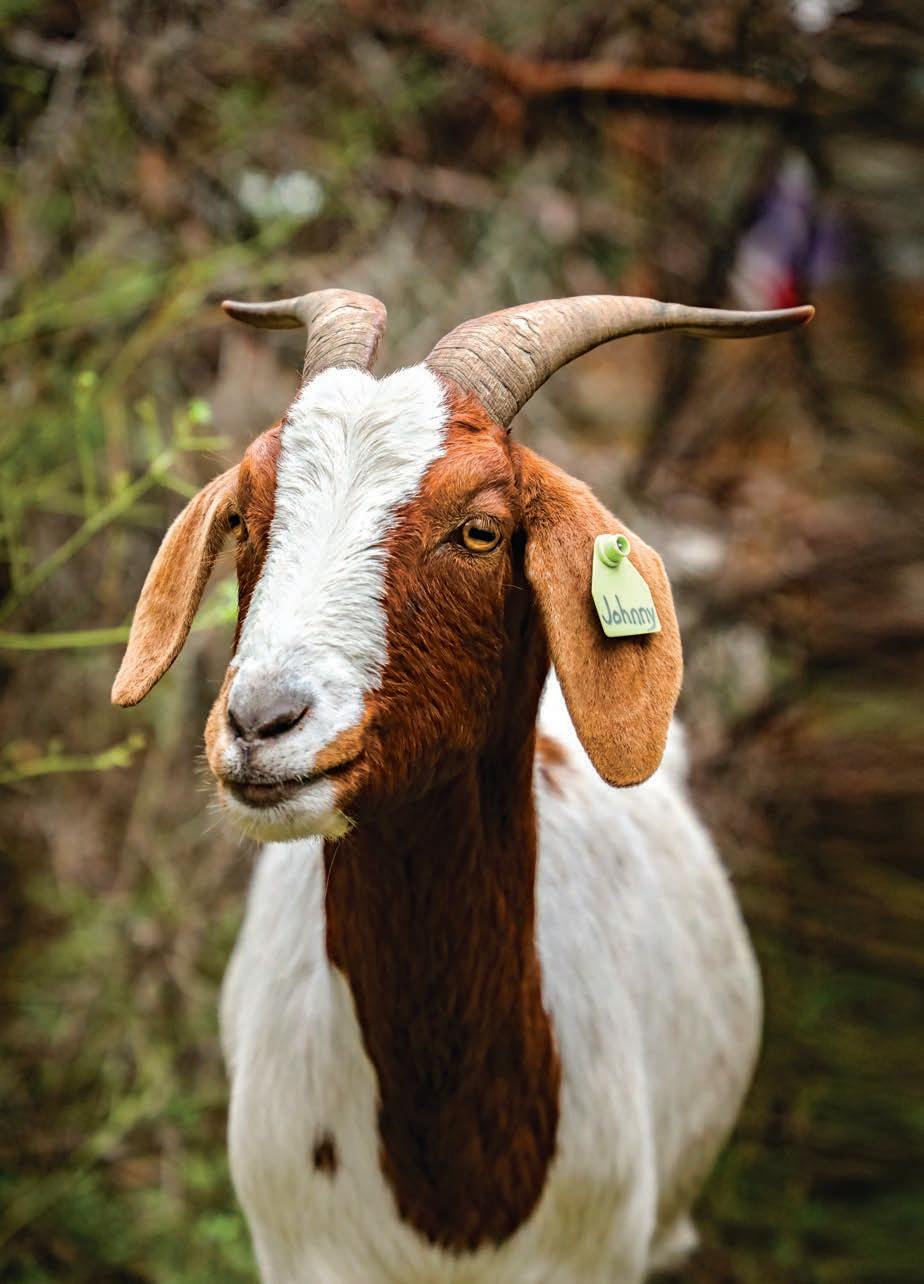
FOR BANDERA EC MEMBERS
MEET THE AMAZING GRACE DANFORTH, M.D.
YOU’LL FALL FOR SUMMER PASTAS

SUSTAINING LONE STAR’S STEEL HISTORY

MEET THE AMAZING GRACE DANFORTH, M.D.
YOU’LL FALL FOR SUMMER PASTAS
They’re good for grazing and crazy about cuddles




You may not realize it, but the homes you build are sitting on a free and renewable supply of energy WaterFurnace geothermal systems tap into the stored solar energy underground to provide savings up to 70% on heating, cooling, and hot water. In fact, the average WaterFurnace owner in Texas pays only $57 per month to heat and cool their homes. WaterFurnace units not only save more money than any ordinary HVAC systems, but also last 40% longer, are quieter thanks to no outdoor equipment, and require less maintenance—which all contribute to higher satisfactions levels from your clients.
Contact our WaterFurnace Concierges Team at waterfurnace.com/TexasPower to learn more today.
Scan to learn more about the benefits of switching to geothermal.

By Pam LeBlanc
By Patti Pfeiffer

MORE THAN THREE years after plans were announced to build a National Juneteenth Museum, Fort Worth officials have made way for the planned 50,000-square-foot museum, food hall, business incubator and theater.
The $70 million museum of Black history will be built on a plot on the city’s Historic Southside, with the city kicking in $15 million. Opal Lee, the “Grandmother of Juneteenth,” gave City Council members two thumbs up.
“Wow, I tell you, I could have hugged everyone, but they’ve got work to do,” Lee told the Fort Worth Report.

ENTER CONTESTS AT TEXASCOOPPOWER.COM
$500 RECIPE CONTEST Turkey Time
FOCUS ON TEXAS PHOTOS Heroes
TEXAS GULF SHRIMP GIVEAWAY
Two readers will each win 5 pounds of wild-caught Texas shrimp. Enter now at TexasCoopPower.com/contests.
Hurricane season begins June 1, and experts expect an above-average year.
Not only is your electric cooperative your trusted energy resource, it also offers invaluable information when severe weather threatens.
Stay safe by staying connected to your co-op’s advice in these pages and on its website and social media feeds.

It’s summer, and I’m ready for ...
Tell us how you would finish that sentence. Email your short responses to letters@TexasCoopPower.com or comment on our Facebook post. Include your co-op and town.
Here are some of the responses to our April prompt: The best view in Texas is ...
A “Welcome to Texas” sign alongside any highway.
MIKE WEBER
UNITED COOPERATIVE SERVICES GRANBURY
From my front porch every time my husband blows me a kiss as he passes on his tractor.
SUZY DOSS PENTEX ENERGY VALLEY VIEW
The Sabine River bridge in my rearview mirror and the afternoon sun shining in my face. I’m home!
JOHN STOLL
BANDERA EC MICO
Getting home and seeing my wife and grandkids outside enjoying the spring weather.
RANDY HARDEE
WISE EC
BRIDGEPORT
Visit our website to see more responses.
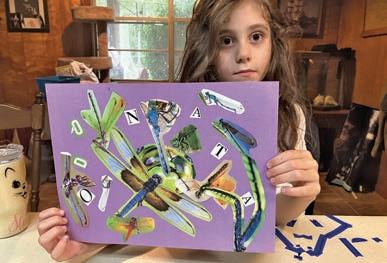
Honestly, I’m not a bug person [Ode to a Mighty Hunter, April 2025]. But I do love dragonflies because they don’t stick to me or bite me.
I never realized there were so many different species of them. These photos are incredible!
The close-up of the eyes is kind of scary. But my favorite part was Love on the Wing. They make a perfect heart.
Denise Sims
Bowie-Cass EC Redwater
Inspiring Flyers, Part II
At 17 my dream was to fly [The WASPs Who Flew Out of Sweetwater, April 2025]. I applied twice for acceptance to the WASPs. I counted the days to hear from them.
It wasn’t to be. To my disappointment they were deactivated. This led me to

MINDY WALKER JASPER-NEWTON EC KIRBYVILLE
serve in another form of communications, which continued the rest of my working life.
I will be 99 this year. Thanks for the memories.
Wanda Tackett
United Cooperative Services Desdemona
Lake of Bluebonnets
Nanny’s Blessing [March 2025] touched my heart. In the 1950s my grandparents turned two acres of their Walker County property into a Texas wildflower field, predominately with Lupinus subcarnosus, the sandyland bluebonnet.
For almost 50 years, those bluebonnets made their property look like a lake, and people often stopped to take photos. To this day the sandyland bluebonnet, with its gentle shade of blue, is my favorite, although, sadly, they seem to be migrating into obscurity.
Jan Lawrence
Sam Houston EC San Jacinto County
Editor,
TEXAS ELECTRIC COOPERATIVES
BOARD OF DIRECTORS
Chair Avan Irani, Robstown
Vice Chair Bryan Wood, San Augustine
Secretary-Treasurer Cameron Smallwood, Burleson
Board Members Dale Ancell, Lubbock
Matt Bentke, Bastrop • Kerry Kelton, Navasota • Mark McClain, Roby
PRESIDENT/CEO Mike Williams, Austin
COMMUNICATIONS & MEMBER
SERVICES COMMITTEE
Mike Ables, Bellville • Kathi Calvert, Crockett
Marty Haught, Burleson • Tachi Hinojosa, Fredericksburg • Gary Miller, Bryan Zac Perkins, Hooker, Oklahoma • Bryan Story, Blossom • Buff Whitten, Eldorado
MAGAZINE STAFF
Vice President, Communications & Member Services Martin Bevins
Editor Chris Burrows
Associate Editor Tom Widlowski
Production Manager Karen Nejtek
Creative Manager Andy Doughty
Advertising Manager Elaine Sproull
Communications Specialist Samantha Bryant
Digital Media Specialist Caytlyn Calhoun
Senior Designer Stacy Coale
Assistant Production Manager Alex Dal Santo
Print Production Specialist Grace Fultz
Food Editor Vianney Rodriguez
Communications Specialist Erin Sinclair
Communications Specialist Claire Stevens
Communications Specialist Kelly Tran
Proofreader Louie Bond
TEXAS CO-OP POWER Volume 81, Number 12 (USPS 540-560). Texas Co-op Power is published monthly by Texas Electric Cooperatives. Periodical postage paid at Austin, TX, and at additional offices. TEC is the statewide association representing 76 electric cooperatives. Texas Co-op Power’s website is TexasCoopPower.com. Call (512) 4540311 or email editor@TexasCoopPower.com.
SUBSCRIPTIONS Subscription price is $5.11 per year for individual members of subscribing cooperatives and is paid from equity accruing to the member. If you are not a member of a subscribing cooperative, you can purchase an annual subscription at the nonmember rate of $7.50. Co-op members: Please notify your co-op of address changes or other subscription requests.
POSTMASTER Send address changes to Texas Co-op Power (USPS 540-560), 1122 Colorado St., 24th Floor, Austin, TX 78701. Please enclose label from this copy of Texas Co-op Power showing old address and key numbers.
ADVERTISING Contact Elaine Sproull at (512) 486-6251 or esproull@texas-ec.org for information about purchasing display ad space in Texas Co-op Power and/or in our 26 sister publications in other states. Advertisements in Texas Co-op Power are paid solicitations. The publisher neither endorses nor guarantees in any manner any product or company included in this publication.
COPYRIGHT All content © 2025 Texas Electric Cooperatives Inc. All rights reserved. Reproduction of this issue or any portion of it is expressly prohibited without written permission. Willie Wiredhand © 2025 National Rural Electric Cooperative Association.
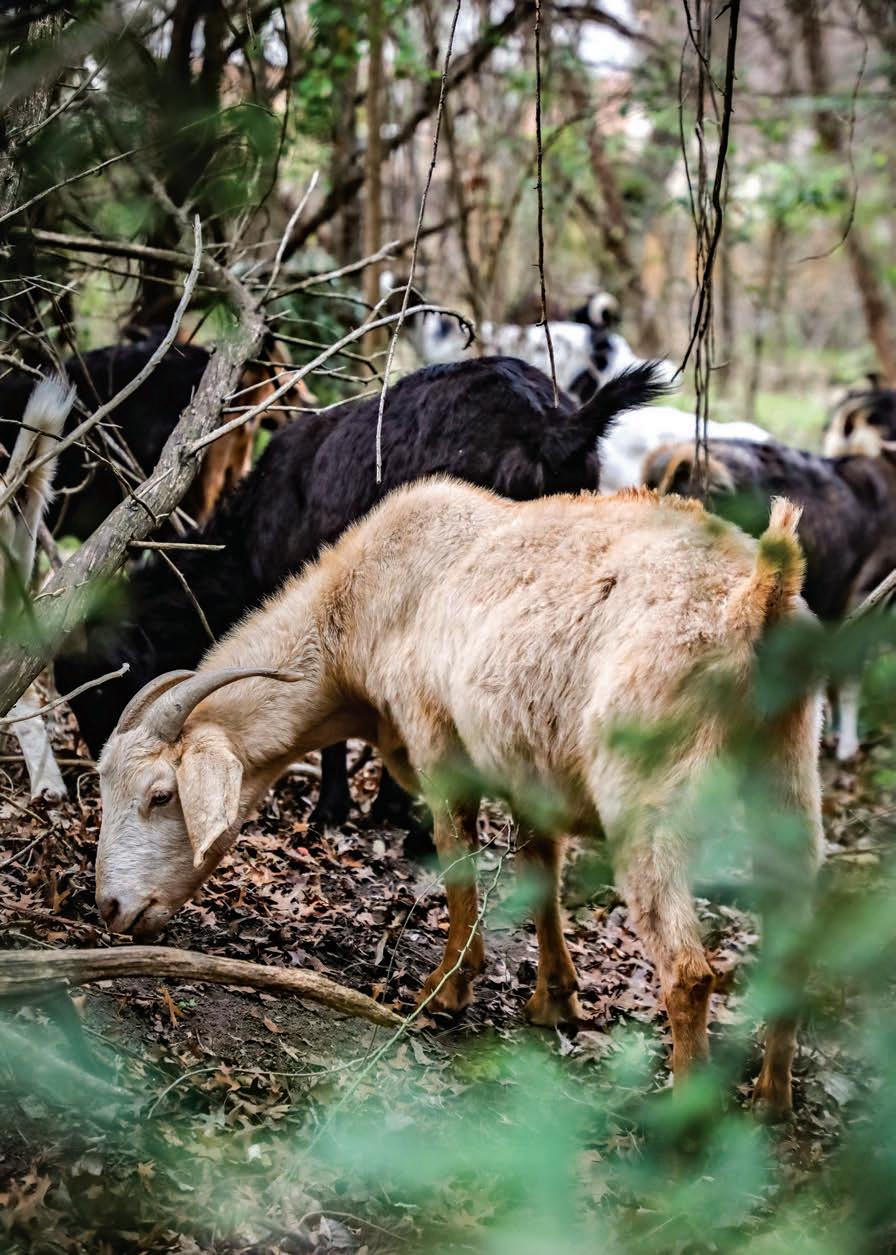
BY PAM LEBLANC
For those
hard-to-remove,
unwanted plants, goats may be the greatest of all time
a steep, overgrown ravine in the Steiner Ranch neighborhood west of Austin, dozens of goats are buzz sawing their way through a thicket of brambles.
The ruminants work through the brush like furry, fourlegged locusts, pausing now and then to share a goofy grin accented with slobbery bits of greenery. Their jaws work nearly nonstop, chewing plants along a trail that winds between houses.
The goats are here to work, hired hands in an army deployed to reduce the risk of wildfire. A blaze in Steiner Ranch during the hot, dry summer of 2011 destroyed 23 homes, and officials are eager to prevent another disaster.
That’s why a homeowners association there teamed with Lake Travis Fire Rescue to hire 100 goats from RentA-Ruminant as part of an experimental fire mitigation program. The animals spent a week clearing out brush on 7 hard-to-access acres. After they make a first pass, human volunteers finish the job, cutting down and removing downed trees and other fire fuel.
Goats, proponents say, are cheaper, greener and safer than humans with lawn mowers or herbicides that could work their way into waterways. And they’re cute.
“They go where man, machine and chemicals can’t go,” says Carolyn Carr, co-owner of Rent-A-Ruminant.
Goatscaping, as it’s sometimes called, is just one form of modern-day goat employment. Besides putting the animals to work clearing poison ivy from urban hiking trails or tidying up grass growing around solar panels, goats can inject a bit of fun into social activities such as yoga, wine tastings and parties.

Carolyn and her husband, Kyle Carr, own a herd of about 600 goats in Brownwood. They hire their animals out to private landowners, municipalities and businesses. Goats, they say, are an eco-friendly solution to maintaining landscaping projects large and small.
The Carrs’ herd is made up of nine breeds of goat. Almost all the animals have names, which are noted on brightly colored tags attached to their floppy ears.
“Goats are great,” Carolyn says as they stream out of a trailer and into a cordoned-off area of land at Steiner Ranch. Curious residents have gathered to watch the proceedings.
The Carrs started their business after inheriting an overgrown piece of property in Brownwood, about 80 miles southeast of Abilene. Carolyn joked at the time that they needed a herd of “green grazers” to tidy things up.
It turned out to be a smart suggestion. Kyle’s father had been a Xerox salesman, with plenty of connections at municipalities around the state. They quickly learned that many of those cities needed help controlling brushy overgrowth.
ABOVE Rent-A-Ruminant owners Kyle and Carolyn Carr manage a herd of about 600 goats that can landscape in hard-to-reach areas.
Goats can clamber up and down steep slopes and reach awkward spaces that heavy machinery can’t access. They also clip vegetation growing along sensitive waterways where herbicides shouldn’t be used. Best of all? They love plants that make humans itch or stab them with thorns or assault airways, including green briar, poison ivy, ragweed and blackberries.
The Carrs travel the state with their herd, which has trimmed up Hermann Park in Houston, munched invasive species while all but ignoring the lush lawn at the Houston Arboretum, and cut back poison ivy along the Ann and Roy Butler Hike-and-Bike Trail around Lady Bird Lake in downtown Austin.
But not just any goat can make the Rent-A-Ruminant team. Only quiet goats that don’t pester people for food can become part of the traveling work crew, Carolyn says.
Sometimes, onlookers set up chairs to watch the goats in action. That’s fine with the Carrs, as long as the humans don’t distract the animals by feeding or petting them.
“They have a job to do, and this is not a petting zoo,” Carolyn says.
Sheep, she says, can do similar work, such as “mowing grass” that grows around rows of sun-collecting panels at solar farms. Both species have their niche—sheep prefer grass over leaves, making them good at keeping lawns and weeds in check. Goats prefer leaves, so they’re better at tidying up unruly brush.
In Steiner Ranch, the experiment seems to be working. The HOA and fire department split the $9,000 tab to hire the goats, and even after a few hours, the difference is obvious.
“We have a lot of area and so much poison ivy,” says Debbie Tanner-Jacobs, president of the Steiner Ranch Residential Owners Association.
As a bonus, the goats leave behind a little fertilizer, in the form of their droppings. Goats, Carolyn Carr notes, sterilize seeds that pass through their bodies, so they can’t repropagate those pesky plants.

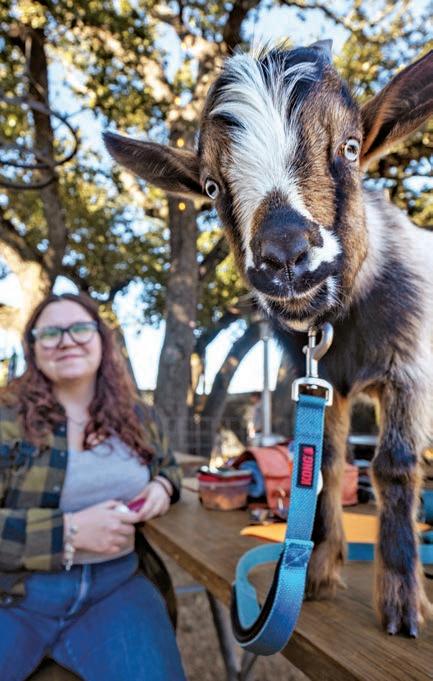



they zoom around an outdoor patio at the winery and accept an overflow of snuggles from their admirers.
“They’re not afraid of people,” Romer says. “They’re motivated by food and love to be cuddled.”
Allyson Marek of San Marcos learned about Goat Shenanigans through social media and bought tickets for the wine tasting with goats for herself and her parents for Christmas.
“They’re just so cute and mischievous and silly,” Marek says as she holds one, a bright-eyed armful of soft hair named Thor with a tongue that sticks out with each bleat. “Oh my gosh, amazing. They’re so soft, so chill, so very awesome.”
San Antonio-based Goat Shenanigans puts goats to work in a different way.
On a crisp afternoon in January, 10 goat enthusiasts convene at Blue Lotus Winery in Seguin, where they sip wine and cuddle a pair of Nigerian dwarf goats, each just three or four weeks old.
Besides happy hours with goats, the company organizes yoga classes, toddler gatherings, movie nights and beer tastings, all in the company of adorable baby goats.
They’ll even deliver a “goat gram”—a livelier version of the traditional candy gram—to your home to celebrate a special occasion. A single-goat visit lasts 20–30 minutes, but you can add additional ruminants to the order.
Goat Shenanigans also offers ranch visits. Visitors can pay for a 10-, 30- or 60-minute session on the goats’ home turf, on the northwest side of San Antonio.
“Whenever a goat is involved, it’s going to be a good time,” says Laura Romer, manager of Goat Shenanigans. “The best thing about them is they have different personalities. A cow is a cow, but a goat has its own unique personality. They’re very loving, very playful and emotionally intelligent. They bring out so much joy in people.”
The goats seem to enjoy their work. Aside from a chorus of high-pitched bleats that sound like out-of-tune harmonicas,
One day, when she has enough land, Marek says, she hopes to own her own herd. She dreams of raising goats for their milk and to make cheese and soap.
Another afternoon, a dozen children and their parents (along with a few adults who can’t resist) gather at the Hive coffee shop in South Austin to mingle on an outdoor patio with four animated, beagle-sized baby goats.
“I like how they’re kind of like dogs but cuter,” says Evelyn Jackson, who has come to the event with her mother, a sister and a friend.
All around Jackson, kids—the human kind—offer the hardworking goats kibble and pet their soft bodies. Two of the goats wander into the coffee shop’s garden, where they sample herbs growing in a raised bed. Another hops onto a picnic table and stares down a woman sitting there.
“How can you be upset with a baby goat in your arms?” asks goat wrangler Sarah O’Brien, who is doing her best to keep her charges in line.
You can’t. And that’s why we need more goats in the workforce. D

BY PATTI PFEIFFER
While a consequential steel mill rusts, locals ensure memories shine on
The Lone Star State is known around the world. The town of Lone Star, however, isn’t well known—even among Texans.
But it should be. So says a group of 13 volunteers working to bring light to the East Texas town of 1,400 people about an hour southwest of Texarkana. They want to share the rich history of its steel plant, metal from which spanned the skies over Vietnam and the subsurface of the oil industry and deeply impacted the U.S. economy, environment and space exploration.
They call themselves the Ladies of Lone Star, and their goal is plain.
“We want to gather memories and record as much of the history of Lone Star Steel as possible for future generations,” Lesley Dalme says.
It all began with an idea about décor.
Randy Hodges, former Lone Star mayor who was technical services manager when his 45-year career at the plant ended with its closing in 2020, proposed adorning the walls of the Lone Star Senior Citizens Center with pictures of the plant. The framed photos caught the attention of locals, and the project was born.


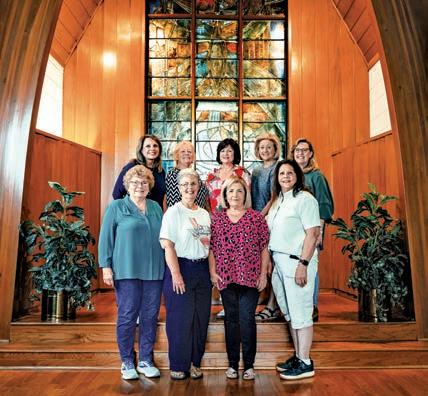
I sat down with three members of the Ladies of Lone Star as well as Hodges and John Shivers, a former plant manager and vice president. For nearly two hours in the chapel on the grounds of the shuttered plant, I listened and learned about the steel industry, the plant’s history and the impact it had on people, places and events far and wide.
The plant was built with federal funding during World War II in the small town of Lone Star, selected because of its strategic location. Nearby are ore, limestone and coal—the three essentials for steel production—and the Port of Houston is driving distance.
While the 600-acre plant came about because of the war, steel didn’t start rolling out until the mid-1940s, after the war’s end. In the early 1950s, the oil industry began booming and with it the market for pipe.
“An idea came about to buy surplus war project product
CLOCKWISE FROM LEFT Several volunteers from the Ladies of Lone Star in the mill’s chapel, the site of hundreds of plant employees’ weddings over the years. A wind tunnel that could simulate the vacuum of space using blast blowers. Randy Hodges, the former mayor of Lone Star who worked at the plant for 45 years, with his father’s hard hat. From left former mill worker Bruce Shimpock and Lesley Dalme and Lanita Goodrum of Ladies of Lone Star look over artifacts.
to manufacture oil pipe,” Shivers says. “It took two years to adjust production and install necessary mills at a cost of $76 million. The oil industry fluctuated, going from boom to bust. Likewise, LSS profited hugely and suffered severely.”
LSS also played a role in the Vietnam War.
“We would make large-diameter tubes to be used as bomb casings, which would be cut to bomb length, shipped by rail or truck to an ammunition plant in Karnack, filled with ammo, a fin was attached, then they would be transported to the Port of Houston,” Shivers says.
The steel mill had a wind tunnel that could simulate the vacuum of space using blast blowers. Known as the Ordnance Aerophysics Laboratory, the highly secure site operated from 1945 to 1968 and employed hundreds of scientists, technicians and engineers. Department of Defense contractors conducted thousands of tests for supersonic jet engines, guided missiles and spacecraft components for the military and NASA.
“The facility was well-known around the community, but because of security, it was not known around the country,” Hodges says. “They researched and designed rocket engines here, including components used for the Saturn rocket. They would bring equipment in on a bread truck, and once inside the plant, securely situated behind closed metal doors, the bread truck doors would open, and parts would be unloaded.”
Members of the project liked the area so much, amid the verdant Pineywoods and alongside the 1,500-acre reservoir

built for the steel plant, many of them stayed and went to work for LSS.
They brought with them a wealth of knowledge and talent that led to industry innovations. For example, a device that scrubbed smokestack emissions was developed at LSS, Shivers says.
“It cleaned better than anything on the market,” he says. “We sold it to other cities—Houston, Shreveport—a nuclear facility in Georgia, and other customers in the U.S. and abroad.”
However, economic downturns in the 1980s plagued the steel industry. In 1989, Lone Star Steel filed for bankruptcy.
“Our labor contract expired, and we worked two years without one,” Shivers says. “We just kept going, no contract and no complaints. It took a couple of years, but we came out of bankruptcy and paid off 85% of the debt, and a few years later were profitable again.”
In 2007, U.S. Steel purchased the plant for more than $2 billion. Nine years later the mill was idled and then completely shuttered in 2020. At the height of production, the company reportedly employed more than 6,000. Now, other than security personnel, the facility is vacant. Equipment sits silent while rust and dust mount.
The Ladies of Lone Star are dedicated to preserving documents dating to the early 1940s and photographs showcasing the plant’s long and vibrant history. They also have begun meeting with former employees, recording and then transcribing their stories to be compiled into a book chronicling the mill’s story.
“The plant is being dismantled, and eventually it will be no more,” says Lanita Goodrum, one of the volunteers. “And it’s even more important that people know what made Lone Star, what those men did in that plant and the impact it had on our nation.”
“ We want to gather memories and record as much of the history of Lone Star Steel as possible for future generations.”
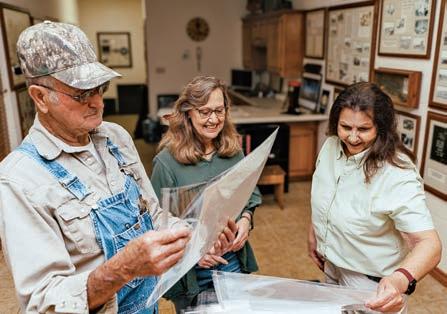
When our time together winds down, Hodges, who started at the steel plant in 1974, offers a trip to the senior center— an invite I eagerly accept. As we walk by each photo on the walls, he enthusiastically explains the images.
“I worked with World War II vets, young men with families—our plant was filled with people like that, hardworking parents who had to make a living regardless of the long hours, the hard and dangerous work,” he says. “In a world that was so divided, we were working for a common cause.”
On top of a piano is something that goes beyond mere nostalgia—Hodges’ father’s hard hat from his long career at the plant. “His first paycheck in 1953 is what paid for my mother to go and me to be born at a hospital,” Hodges says. “It was more than a job and career. We were family.”
And it was a family that survived, thrived, accomplished a lot and had an enormous impact. They are proud of LSS, still—its impact of 80 years, from Earth to the heavens, the industries it changed from oil to aerospace, and the lives it touched.
As Shivers says, “Our footprint ranges far beyond this steel plant.”D

Luxury Swiss brands like Rolex® and Patek Philippe® charge thousands, but the Stauer Swiss Tactical Watch delivers the same precision for less. Inspired by military timepieces like the A-11, it’s built for action with rugged design and expert craftsmanship.
Swiss Precision, Limited Edition
Each watch takes nearly nine months to complete and only 4,900 will be made. Crafted by master watchmakers — some from top luxury brands — this is true Swiss quality without the inflated price.
Built for Performance
With high-contrast markers, a shock-resistant case, and Swiss-made movement, it’s designed for reliability, not status.
Limited Offer – Act Now
Why pay more when you can own precision, heritage, and adventure for less? With only 4,900 available, when they’re gone, they’re gone. Order now — time is running out.
Watch Specifications:
• Made in Switzerland with precision
• Swiss Ronda 515 movement.
• Stainless steel caseback.
• Brown leather band.
• 44 mm diameter case.
• Date window at 3 o’clock.
• Water-resistant to 3 ATM.
• Fits wrists up to 8 ¼"
Stauer Swiss
Tactical Watch
$399 $59*
+ S & P Save $340
*Special price only for customers using the offer code.

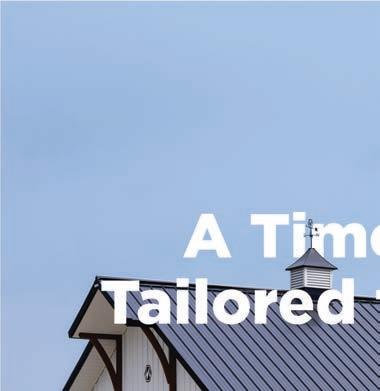



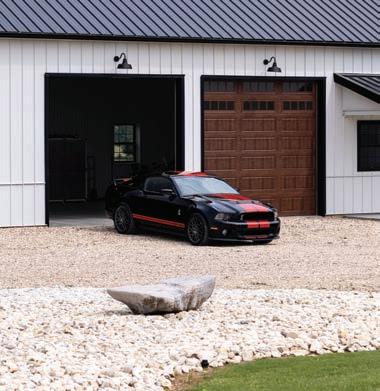






MESSAGE FROM CEO
WILLIAM “BILL” HETHERINGTON
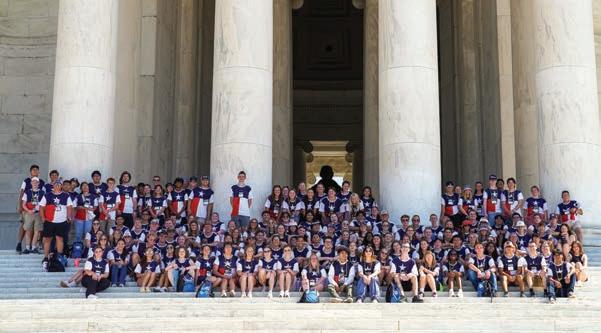
LYNDON B. JOHNSON, a Texas native and the 36th President of the United States, understood the value of a quality rural life. He was instrumental in bringing electricity to the rural areas of the Texas Hill Country. To accomplish this required political perseverance. He also recognized how vital it is to educate our youth about the value of our founding principles, the meaning of democracy, and the significance of public service. In 1957 he called on Electric Cooperatives to send youths to Washington D.C. to “actually see what the flag stands for and represents.”
In June 1965, along with other electric cooperatives, Bandera started sponsoring high school students to attend a weeklong Government-in-Action Youth Tour in Washington D.C. Now, 60 years later, it is still going strong with more than 50,000 student participants nationwide.
One of the most important aspects of this program is the opportunity to learn leadership skills. Participants are provided with meaningful ways to assist in leading activities, contribute to discussions and decision-making, and take an active role in learning about our Constitution and American democracy. Through their participation, they learn how to overcome challenges in the real world, like how to communicate effectively and collaborate with others outside of their families and close circle of friends. When young people are
given opportunities for leadership, learning, and friendship, it will help them advance their skills and instill confidence.
From past participants we know that they come away with new skills, friendships, and they gain an understanding of the importance of leadership and civilian participation in our democratic process. Past participants have extolled the benefits from participating in this program, calling it an “excellent opportunity to seek inspiration and make lasting memories.”
Participation in this Youth Tour is encouraged at our local high schools. The students are required to write an essay answering the following question: “Which of the rights guaranteed by the first ten amendments to the US Constitution do you consider the most important?”
The winners are selected by an independent community foundation to ensure a fair and unbiased selection.
This year we have four students from our area that have been selected to participate. They will be traveling to both Austin and Washington to meet with our elected officials, tour historically significant places, learn about government, and make new friends.
I’m proud that BEC continues to invest in our youth. In doing so we are strengthening our communities and helping to build the leaders of tomorrow.
ON THE MORNING OF WEDNESDAY, April 16, Bandera Electric Cooperative welcomed members of the community to its headquarters for Coffee & Conversation with BEC Executives, a casual, come-and-go event designed to foster open communication between BEC leadership and the members we serve.
Held in the BEC Community Room at our Bandera headquarters, the event provided a warm and welcoming environment for members to ask questions, share feedback, and learn more about BEC’s initiatives and services. Attendees had the opportunity to chat directly with members of BEC’s executive team and Board of Directors, gaining insight into the cooperative’s priorities, projects, and long-term goals.
From discussing new technologies and infrastructure improvements to learning more about member programs and energy solutions, the conversations were as rich and mean-
ingful as the coffee served. The event was a reflection of BEC’s commitment to transparency, accessibility, and community engagement.
We appreciate every member who took the time to stop by, share their thoughts, and connect with our leadership team. Your voice matters—and events like these help shape the future of our cooperative.
Stay tuned for future Coffee & Conversation events and other opportunities to engage with BEC leadership. Together, we’re building a stronger, more connected community—one cup at a time. We look forward to seeing you at the next Coffee & Conversation event soon! D

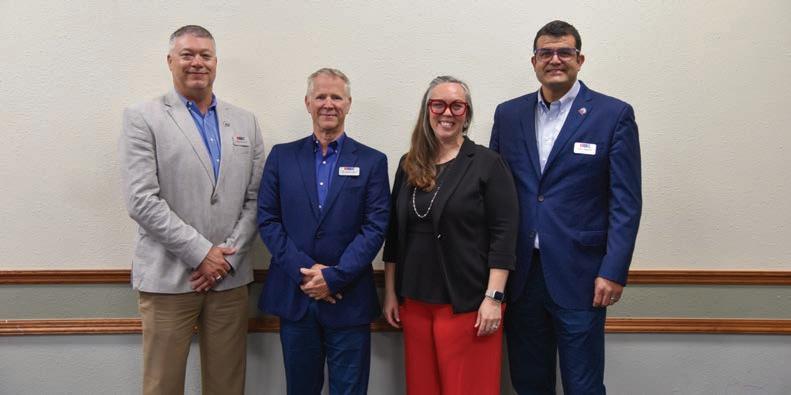

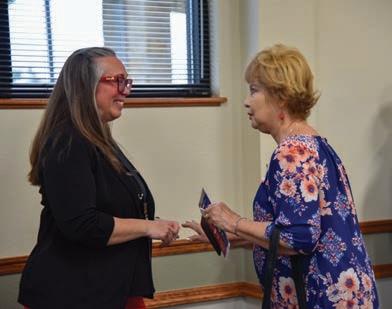
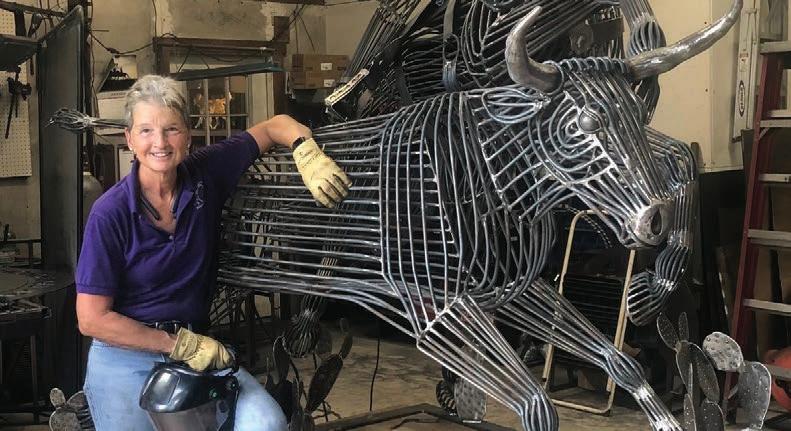
ESTHER BENEDICT’S JOURNEY FROM the world of horseshoeing to becoming a renowned sculptor is one of passion, perseverance and a touch of serendipity. Her introduction to metalwork came through the demanding craft of horseshoeing.
“I was shoeing or trimming at least 580 horses on a rotation — crazy, right?” she said with a laugh, recalling the physically intense career she once had. Despite the grueling work, Esther quickly discovered a special connection with the medium. “I really love how pliable the steel is,” she said, describing the tactile joy of shaping metal — a skill that later translated seamlessly into sculpture.
Her path toward art wasn’t exactly straightforward. From a young age, Esther was drawn to two passions: horses and art. “I was always interested in horses or art,” she said, reflecting on how those dual interests guided her throughout life. After years as a farrier, a moment of clarity nudged her in a new direction.
“I started watching my farrier friends walk funny after 20 years, and I thought, maybe I’ll get out before that happens.”
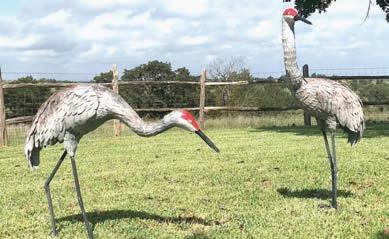
That foresight led her to explore sculpture — a leap that came with its own set of challenges.
One defining moment came when she created her first piece of art. “The very first piece I ever made — someone bought it at that first show. I was so excited!” That initial success validated her decision and marked the start of something much bigger. Her signature style — an elegant blend of line sculpture and intricate detail — soon began drawing attention.
“That line sculpture style became my signature,” she said, recalling how it helped establish her identity in the art world.
As her skills evolved, so did her ambitions. A turning point came when a collector asked, “Can you make a life-size one?” Esther admitted, “I had no idea how, but I figured it out.” That fearless approach launched her into the world of large-scale sculpture, a niche that now defines much of her portfolio.

Today, her work can be found in public art spaces and private collections across the country — and beyond.
Another major chapter began when Esther relocated to the Texas Hill Country. She was drawn by the region’s natural beauty and peaceful atmosphere.
“I thought, why don’t I move to Texas and visit New York?” she said. But once she arrived, she never looked back. Her home in the Hill Country is more than just a residence — it’s her creative sanctuary. “The gallery is on the property, and the studio and house are in the back,” she said with pride.
Esther has been a proud member of Bandera Electric Cooperative for nearly two decades. Over the years, she’s watched the region grow, evolve and embrace technology — something that has helped her work flourish. As a BEC Fiber subscriber, she says high-speed internet has become an essential tool in her artistic process.
“I’m online a lot, of course. We’re emailing all the time — and the faster, the better,” she said. Whether she’s coordinating with clients or researching a new subject, fiber internet keeps her connected. “If I’m going to do an eagle, I just go online and pull up pictures from every point of view I can get,” she said, noting how vital it is to her workflow.
Success followed in waves. From selling her first sculptures at local shows to the unexpected sell-out of a recent wine charm event, the demand for her work continues to grow.
Today, Esther’s sculptures reside in collections around the world, “I have a wolf in New Zealand and a horse sculpture in England,” she said proudly. Those far-reaching connections speak volumes about her talent and drive.

Through years of hard work, a passion for her craft and a fearless attitude, Esther Benedict has created a body of work that continues to captivate and inspire.
To learn more about Esther’s sculptures and view her work, visit ebenedictmetalart.com. Local venues where you can view her art include:
Old Town Helotes Main Circle, Helotes, Texas
Natural History Museum, Bandera, Texas
Visitor Center, Bandera, Texas
Western Trail Antiques Mall, Bandera, Texas
Texas Art and Craft Show, Kerrville, Texas D




Juneteenth Thursday,

Fallacy: Setting the thermostat to a cooler temperature than ultimately needed will make the air conditioner cool faster.
Fact: An air conditioner runs at the same rate until it reaches the thermostat setting. If you set it to a colder temperature, you might forget to put it back to normal and use more energy than necessary.
Fallacy: Using a bigger air conditioner will cool my house better.
Fact: A smaller air conditioner that runs for a slightly longer period is more efficient than a larger unit that cools the house with short run times. Having an AC professional determine the right-sized system for your home is the optimal solution.
Fallacy: Using an old refrigerator or freezer as a spare is reasonable.
Fact: Old fridges and freezers are usually significantly less efficient than newer models, and keeping the appliance going can cost extra money for minimal benefit. Consider getting rid of the old fridge and using an ice chest instead when you occasionally need additional cold storage.
Fallacy: Duct work should be sealed with duct tape.
Fact: Despite the name, duct tape is not the best tool for the job. Poor surface preparation and dusty environments often cause the tape to fall off. The tape also is not as durable as the preferred sealants—mastic or metal tape.
Fallacy: Ceiling fans only save energy during warm weather.
Fact: Circulating air with ceiling fans saves money in all seasons—when on the right setting. In summer, change the rotation of the blades to counterclockwise to direct air down, making the room feel up to 4 degrees cooler. In winter, direct air upward with the blades rotating clockwise. D


LOOKING FOR A WAY TO take control of your energy use and lower your electric bill? Bandera Electric Cooperative’s TimeBased Usage (TBU) program gives members the power to do just that.
TBU is a voluntary rate program that allows members to save energy and money by shifting their electricity use away from peak hours—when energy costs the most—and toward off-peak hours, when rates are lower. Unlike traditional flat rates where you pay the same amount no matter when you use electricity, TBU rates vary depending on the time of day and season.
Saving with TBU is as simple as making a few small changes to when you use power in your home. Here are a few easy ways to start:
• Run your washer and dryer during off-peak hours.
• Adjust your thermostat by a few degrees during peak times.
• Cool your home at night when rates are lower.
• Shift cooking and appliance use to times outside of peak periods.
These small adjustments can lead to real savings over time—all while helping the cooperative manage demand more efficiently.
Time-Based Usage may not be right for everyone, but many of our members are already seeing the benefits of making the switch.
Want to learn more? Scan the QR code to watch our explainer video or give us a call at 866.226.3372.D




8 ounces cream cheese, softened
½ cup finely shredded cheddar cheese
½ cup chopped jalapeño peppers
⅓ cup cooked and crumbled bacon
½ teaspoon salt
Pinch cayenne pepper (optional) 30 phyllo shells
Pickled jalapeño slices, for garnish
1. Preheat oven to 350 degrees.
2. In a bowl, combine cream cheese, cheddar, chopped jalapeños, bacon, salt and cayenne, if using, until smooth and uniformly mixed.
3. Use 2 spoons or a small cookie scoop to divide mixture among phyllo shells. Place filled shells on a rimmed baking sheet and bake 10 minutes or until shells are crisp and filling is just starting to brown.
4. Let cool slightly and top each shell with a slice of pickled jalapeño. Serve warm.
MAKES 30 POPPERS
DO YOU HAVE A MOUTHWATERING take on jalapeño pepper bites? Whether they’re stuffed, wrapped, baked, or grilled—we want to see your version!
Submit your recipe and a photo for a chance to win a cast iron skillet and a Texas Co-op Power cookbook full of Texas-inspired flavor. The photos will be posted to our Facebook page for voting, so make sure your bites bring the heat!
Scan the QR code to enter the contest and share your recipe! D


CONTACT US
CONTACT US
P.O. Box 667 • Bandera, TX 78003
P.O. Box 667 • Bandera, TX 78003
Toll-Free 1-866-226-3372 (1-866-BANDERA)
Toll-Free 1-866-226-3372 (1-866-BANDERA)
Web banderaelectric.com
Web banderaelectric.com
Email mas@banderaelectric.com
Email mas@banderaelectric.com
Board of Directors
Board of Directors
District 1 Robert Aguirre
District 1 Robert Aguirre
District 2 Frances “Fran” Laue
District 2 Frances “Fran” Laue
District 3 Jeffery “Jeff” Slocum
District 3 Jeffery “Jeff” Slocum
District 4 Jeremy Diller, Vice Chairman
District 4 Jeremy Diller, Vice Chairman
District 5 Annegreth “Anna” Niemann
District 5 Annegreth “Anna” Niemann
District 6 Richard “Dick” Earnest
District 6 Richard “Dick” Earnest
District 7 Christopher “Chris” Blakemore
District 7 Christopher “Chris” Blakemore
District 8 Michael D.T. Edwards, Chairman
District 8 Michael D.T. Edwards, Chairman
District 9 Kurt Solis, Secretary-Treasurer
District 9 Kurt Solis, Secretary-Treasurer
Key Staff
Key Staff
William “Bill” Hetherington, CEO
William “Bill” Hetherington, CEO
Stephanie Pankratz, CFO
Stephanie Pankratz, CFO
John Padalino, General Counsel and CAO
John Padalino, General Counsel and CAO
Shane Schmidt, COO
Shane Schmidt, COO
Mission Statement
Mission Statement
Our mission is lighting the grid to empower our members.
Empowering communities with reliable and innovative services and technologies to enhance everyday life.
Vision Statement
Vision Statement
Reimagining rural America.
Building a sustainable and connected future together.
banderaelectric.com/OM
OFFICES
For hours and information, visit banderaelectric.com/hours.
For hours and information, visit banderaelectric.com/hours.
Bandera Headquarters | 3172 Highway 16 N.
Find this and more delicious recipes online at TexasCoopPower.com. BEC Fiber
Boerne | 1100 N. Main St., Suite 104
Bandera Headquarters | 3172 Highway 16 N. Boerne | 1100 N. Main St., Suite 104
Comfort | 739 Front St. (Highway 27)
Comfort | 739 Front St. (Highway 27)
Leakey | 485 W. Ranch Road 337
Leakey | 485 W. Ranch Road 337
PAYMENT OPTIONS
PAYMENT OPTIONS
For a list of accepted payment options, visit banderaelectric.com/paymentoptions
• myBEC online or mobile app bill payment
• Free bank draft service
• Paperless billing
FOLLOW US
• Level billing

• Automatic recurring credit card payment
• Visa, Mastercard and Discover accepted
• ECheck payment by phone
• Cash or check payments in office

• 24/7 payment kiosks
CONTACT US
P.O. Box 667 • Bandera, TX 78003
Phone 1-866-226-3372, option 5
Web BECFiber.com
Email mas@banderaelectric.com


FOLLOW US








The trailblazing doctor was a champion of women’s rights
BY CLAY COPPEDGE • ILLUSTRATION BY STEPHANIE DALTON COWAN
THE DALLAS Daily Times-Herald tried to compliment Dr. Grace Danforth by saying she was “a woman with a man’s mind,” but the pioneering physician had a mind all her own.
Danforth was the first woman accepted as a member of the Dallas County Medical Association, the first woman to practice medicine in Williamson County and a founding member of the Texas Equal Rights Association.
Danforth was also a member of the Woman’s Christian Temperance Union, which made her death from a drug overdose all the more puzzling.
Born in Wisconsin in 1849, she lived
most of her life in Texas, moving with her family to northeast Texas as a young child.
For a while it appeared she would follow in her father’s footsteps as a traveling music teacher, but she found the classroom too confining. She considered bookkeeping and pharmacy before deciding on medicine, studying at the Woman’s Medical College of Chicago, where she first became involved in the campaign for women’s voting rights.
She returned to Texas as a licensed physician and dedicated suffragist.
By 1889, she was practicing medicine in the small town of Granger, north of Austin, at a time when there were only
a few thousand female doctors in the U.S. She organized local suffrage groups and promoted their activities. She advocated for inviting visionary suffragist Susan B. Anthony to Texas.
We know now that Danforth suffered from cluster headaches, which are uncommon, unpredictable and debilitating. And even though Danforth may have prescribed laudanum, a tincture of opium dissolved in alcohol, to treat pain and other ailments in her patients, she didn’t take it herself.
It’s possible she only took it once, on the night of her 46th birthday, February 21, 1895, when she died of an overdose. Stories about her death vary. Some say she overdosed on the drug antipyrine; others say laudanum.
Armies and expeditions of the day didn’t leave home without laudanum. Lewis and Clark took the drug, along with some raw opium, on their voyage of discovery. Doctors in the 19th century prescribed laudanum for nearly everything: colds, meningitis and even heart diseases.
Laudanum, it seems, never failed to make patients feel better. Unless it killed them.
Wayne Bethard, a pharmacist and historian in Texas, wrote in his book Lotions, Potions, and Deadly Elixirs that laudanum, like today’s opiates, lowers a patient’s pain threshold. Over time it takes more medicine to treat the same pain, but someone who doesn’t take narcotic pain medication has no tolerance to the drug. A dose large enough to calm a cluster headache could be fatal.
“Dr. Danforth was one of the most remarkable women in Texas,” the Daily Times-Herald wrote the day after her death. She was buried in the Granger City Cemetery.
“There was a great prejudice existing against her sex entering the learned professions, and it is not likely she got much practice,” the newspaper wrote. “But she was a woman of a vigorous and active mind, and she soon took a leading part in all reforms.” D
We say summer, but you’ll be turning to these dishes all year
BY VIANNEY RODRIGUEZ, FOOD EDITOR
A pan of homemade lasagna bubbling away in the oven is so dreamy, but this food editor is busy, so I’m busting out a skillet to re-create the dream in under 30 minutes on the stovetop. I finish by quickly broiling the cheese—an optional step but so worth it.

2 tablespoons olive oil
1 pound ground turkey
½ medium onion, diced
2 cloves garlic, minced
1 jar marinara sauce (24 ounces)
1½ cups chicken broth
1 cup sliced fresh mushrooms
10 uncooked lasagna noodles, broken into 2-inch pieces
1 cup ricotta cheese
1/4 cup grated Parmesan cheese
1 teaspoon Italian seasoning
1 teaspoon salt
1 cup shredded mozzarella cheese
1. Heat olive oil in a 12-inch oven-safe skillet over medium-high heat. Add ground turkey and onion. Break up turkey with spoon and cook until turkey is fully cooked, about 8 minutes. Stir in garlic and cook an additional 2 minutes.
2. Add marinara sauce and broth. Bring to a boil.
3. Add mushrooms and lasagna noodles and stir to separate noodles. Return to a boil, then reduce heat, cover and cook 10–12 minutes or until noodles are tender, stirring occasionally. If using broiler, preheat it while the noodles cook.
4. In a bowl, stir together ricotta, Parmesan, Italian seasoning and salt.
5. Dollop cheese mixture by the spoonful on top of pasta. Cover and cook 5 minutes, until cheese is warmed through. Uncover skillet and top with mozzarella. If desired, broil 3 minutes or until cheese is melted and lightly browned. Serve warm.
SE RVES 6
Follow Vianney Rodriguez as she cooks in Cocina Gris at sweetlifebake.com, where she features a recipe for Queso Mac and Cheese.

NANCY GRIFFITH
BANDERA EC
Griffith’s dish is a tasty combination of fresh veggies and pantry staples, making it a new addition to my list of rotating meal plans. As the pasta cooks, I can quickly chop up the veggies, and the dressing is a snap to whisk together. I served it with baked chicken, but it would also be amazing with fried chicken or baked salmon.
16 ounces uncooked rotini
½ cup red wine vinegar
½ teaspoon dried oregano
½ teaspoon ground cumin
½ teaspoon salt
½ teaspoon ground black pepper
½ cup avocado oil
1 can black beans (15 ounces), rinsed and drained
1 ½ cups corn kernels
2 tomatoes, diced
1 red bell pepper, diced
½ cup sliced black olives
1/4 cup chopped fresh cilantro
½ cup diced green onions
1/4 cup diced red onion
1. Cook rotini according to package directions.
2. In a large bowl, whisk together vinegar, oregano, cumin, salt and pepper. Whisk in avocado oil.
3. Add rotini to the dressing and stir to coat. Stir in beans, corn, tomatoes, bell pepper, olives, cilantro, green onions and red onion until thoroughly combined.
4. Cover and chill until ready to serve.
SE RVES 8
CONTINUED ON PAGE 28 >

PATRICIA

Pickle pasta, where have you been all my life? The way I devoured this pasta—it’s so, so good and even easier to whip up. I mean, c’mon— pickles, ranch and bacon … winner, winner.
12 ounces uncooked large elbow macaroni
1 cup mayonnaise
½ cup sour cream
1/4 cup pickle juice
2 tablespoons ranch seasoning
1/4 cup diced dill pickles
8–10 slices bacon, cooked and crumbled
2 cups cherry tomatoes, quartered
2 tablespoons fresh dill, minced (optional)
1. Cook macaroni according to package directions and allow to cool.
2. In a large bowl, stir together mayonnaise, sour cream, pickle juice and ranch seasoning.
3. Add macaroni, pickles, bacon and tomatoes and stir until well combined.
4. Serve garnished with fresh dill, if desired.
SE RVES 6–8
TURKEY TIME DUE JUNE 10
We’re already thinking about the holidays, and you could win $500 if you do too. Tell us about your main dish or what you do with that mountain of leftover turkey. Enter by June 10.
UPCOMING: HOLIDAY BREAKFAST DUE JULY 10

KERRI RUSS
TRINITY VALLEY EC
I appreciate a pasta dish with texture. I want it to be crispy or crunchy, and this pasta gives it to me. I enjoyed this dish when I first made it but even more the next day for lunch.
12 ounces uncooked fusilli
10 ounces frozen peas
4 tablespoons extra-virgin olive oil, divided use
3 ounces prosciutto, diced 2 cloves garlic, thinly sliced
1 tablespoon lemon juice
½ teaspoon salt
½ teaspoon ground black pepper
1 cup grated Parmigiano-Reggiano cheese, divided use
½ cup chopped fresh parsley, divided use
1. Cook fusilli according to package directions and set aside.
2. Steam peas according to package directions and drain.
3. In a skillet, heat 1 tablespoon olive oil over medium-high heat. Add prosciutto to the skillet in a single layer and fry until crispy. Place on paper towels to drain.
4. Add remaining 3 tablespoons olive oil to skillet, along with garlic. Cook until garlic begins to brown.
5. Pour garlic mixture into a large bowl, and add prosciutto, fusilli, peas, lemon juice, salt and pepper to bowl. Stir to coat.
BY VIANNEY RODRIGUEZ
Next time you’re making spaghetti or fettuccine Alfredo, don’t toss the water used for cooking pasta. Save a few cups before draining and reap the tasty benefits. It’s loaded with rich starch from the pasta. Adding a cup or so of pasta water can help emulsify any sauce. It enhances flavor absorption, prevents pasta from drying out and helps sauce cling to pasta.
6. Stir in 3/4 cup Parmigiano-Reggiano and ¼ cup parsley.
7. Serve garnished with remaining ¼ cup Parmigiano-Reggiano and ¼ cup parsley.
SERVES 4







Lace up for an eerie hike among former zoo pens in this boomtown
BY CHET GARNER
THE CAGES WERE all empty—at least what was left of them. But that didn’t stop me from having the strange feeling that something was watching me as I hiked through the remnants of an abandoned zoo just outside Cisco.
This small town is about 100 miles west of Fort Worth and boasts a couple claims to fame. First is the Mobley Hotel—the initial hotel purchased by Conrad Hilton, in 1919—and second is an infamous 1927 bank robbery led by a man dressed as Santa Claus.
And third is the old zoo nature trails on the banks of Lake Cisco.
The zoo was built in 1923, during the height of an oil boom. It was to be the crown jewel of a tourist camp that also included a huge swimming pool just below the newly formed lake.
At its peak, the zoo had a number of cages built into the sandstone cliffs and held a strange menagerie of animals, including a bear, deer and flamingo. Sadly, its heyday was short-lived as animals died under “unusual circumstances,” and by the 1930s, everything was abandoned.
For decades, the ruins of the zoo were known to only a few, and it seems most of them were graffiti artists. It wasn’t until 2021 that a local nonprofit got permission to clear the paths, haul out the garbage and turn the old zoo into a public nature trail.
Walking the paths and peering into the old cages makes for an interesting, albeit creepy, nature walk. Pieces of rusted metal mark the outlines of the former enclaves. The only sounds you’ll hear are the wind and the occasional bird or squirrel scampering up a tree.
But it isn’t hard to imagine the growls of bears and howls of monkeys or those beady little eyes peering back at you. D
ABOVE The empty habitats of an abandoned zoo embolden Chet.
Watch the video on our website and see all Chet’s Texplorations on The Daytripper on PBS.
Call ahead or check an event’s website for scheduling details, and check our website for many more upcoming events.
7
13
Brenham Highwaymen Show: The Great American Outlaws, (979) 337-7240, thebarnhillcenter.com
Grapevine Dairy Day, (817) 410-3185, grapevinetexasusa.com
Fredericksburg [13–14] Craft Beer Festival, fbgcraftbeerfestival.com
14
16
East Bernard Czech KolacheKlobase Festival, (979) 5331902, kkfest.com
El Campo Kids Fishing Tournament, (979) 275-1600, eclostlagoon.com
Slaton Texas Air Museum Airshow, (806) 779-7332, thetexasairmuseum.org
Granbury [14–15] Lone Star Street Rod Association State Run, (817) 573-5548, visitgranbury.com
Terrell [14–15] North Texas Antique Tractor and Engine Club Show and Pull, (214) 497-1611, north-texasantique-tractor-and-engineclub.net
Denton [16–21] Juneteenth Celebration, (940) 735-6311, dentonjuneteenth.com
21
Freeport Fort Velasco Day, (979) 233-0066, freeportmuseum.com
Luling [26–29] Watermelon Thump, (830) 875-3878, watermelonthump.com
Teague Putt Fore a Purpose, (903) 389-5792, fairfieldtexaschamber.com
Belton [28, July 2–5] 4th of July Celebration, (254) 939-3551, beltonchamber.com
Llano [28–Sept. 28] Canvas and Quilts: The Art of Ira and Kathy Kennedy, (325) 247-4839, llanofineartsguild.com
Waxahachie [3–4] Crape Myrtle Festival, (469) 3094045, waxahachiecvb.com
4
Carthage Lake Murvaul Fourth of July Celebration, (903) 693-6562, panolacountytexas.com
Corsicana Freedom Festival, (903) 654-4874, visitcorsicana.com
Grapevine 4th of July Extravaganza, (817) 410-3185, grapevinetexasusa.com
Port Arthur Fireworks on the Seawall, (409) 985-7822, visitportarthurtx.com
Tomball July 4th Celebration & Street Fest, (281) 290-1035, tomballtx.gov
Granbury [4–6] Hometown 4th of July Celebration, (817) 573-1622, granburychamber.com Submit


































































1 BLAIR RINCONES, PEDERNALES EC
“The first time our kids experienced the Gulf Coast, the heart-shaped sunset made it truly a magical experience.”
2 TARYN JENKINS, TRINITY VALLEY EC “A beach trip before a college send-off.”
3 ELIZABETH WEBB, CHEROKEE COUNTY EC “Climbing up to the summit of Enchanted Rock.”
4 DANICA PETERS, PEDERNALES EC “Summer lake days and jumping off the boat.”


Whether going overseas or just over yonder, these readers love picnicking, beach combing, hiking, riding the rivers and cheering on their favorite teams as a family. Now pile in the family van, and let’s have some fun!
CURATED BY GRACE FULTZ


DUE JUN 10 Heroes
DUE JUL 10 Abstract
DUE AUG 10 Country Life
Enter online at TexasCoopPower.com/contests.
See Focus on Texas on our website for many more Family Vacation photos from readers.

Sometimes it takes a chain saw to get through the undergrowth of life
BY PATTI JONES MORGAN ILLUSTRATION BY HEATHER GATLEY
ONE MORNING AS I walked along a nearby lane, a chain saw’s rough growl cut through the early morning peace. Startled, I discovered its source was a trim-looking man bent almost double, systematically attacking dense undergrowth along his fence line.
“Good morning!” I called out.
Finally hearing my voice over the sound of the machine, the man straightened up. “Good morning!” he replied.
“You have a lot of work there!” I called back.
He took my greeting as a welcome excuse to take a break and struggled to disengage from a tangle of old wire fencing, clinging branches and thorny tendrils. Over time, they had wound around the trees and bushes, roots, and fence posts to create a near impenetrable barrier.
Slipping off the mask that had been protecting him from clouds of wood shavings and dust, he tipped back his broad-brimmed hat with a friendly smile. He had just bought the 10 acres, he explained, and planned to build a house on it for him and his wife.
“A lot of wires, mostly rusted, and old brush have wrapped around the fence posts,” he said, waving at the stringy assortment of tethers once intended to define the acreage and warn away trespassers.
Left uncontrolled, however, nature had ravenously begun converting old and new companions into little more than an unmanageable thorny fortress. No wonder wire cutters and a chain saw were needed to hack through the knots and reveal what lay hidden.
We bid our goodbyes after the neighborly visit, and the chain saw resumed its noisy attack on the underbrush jungle.
But not before I saw my own tangle—of old literary aspirations in need of similar treatment. The cacophony inspired me to clear out yesterday’s words and give light, air, time and space to new ones.
A long sweltering summer arrived, partnered with the pandemic. My neighbor’s sporadic chain saw activity diminished to rock gathering and wheelbarrow work.
Curious neighbors, eager to chat, began stopping by. Robert Frost’s oft-quoted line from his poem Mending Wall sprang to mind: “Good fences make good neighbors.” A conversation hub during those communication- cramped months, the gathering place had served us all well.
Completed, his low rock wall continued to speak simply about what mattered: people, purpose and permanence.
It spoke my language too. Half-hidden beneath my writing clutter lay the lyrical sounds and familiar rhythms of my old love, poetry. Revealed anew, its purpose suddenly mattered more than ever.
The chain saw’s discordant sound that first morning had, it seemed, pealed an unexpected welcome. Its clarion call was sweet music to my ears. D















Henry Repeating Arms builds guns the right way, right here in America. For plinking, hunting, collecting, passing down America’s shooting sports heritage to the next generation, or protecting your family and property, choose from over 200 different models of rifles, shotguns, and revolvers in a wide variety of calibers and finishes.









We invite you to order our FREE CATALOG to find your Henry. Every catalog includes decals, the Henry Repeater newsletter, and a personalized list of Henry Dealers in your area.






























































